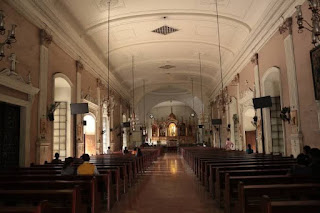Places in Pasig that you might haven't heard yet
When exploring the rich history of the Philippines, a visit to Immaculate Conception Cathedral in Pasig City is a must. This cathedral, also known as Pasig Cathedral, is a significant landmark that reflects the country's deep Catholic heritage and Spanish colonial past.
A Glimpse into History
The Immaculate Conception Cathedral is one of the oldest churches in the Philippines, with roots tracing back to 1573 when it was established as a small parish by Augustinian missionaries. Over the centuries, it underwent several renovations, eventually being elevated to a cathedral in 2003 under the Diocese of Pasig.
Architectural Beauty and Serenity
Upon arrival, the cathedral’s Spanish Baroque architecture immediately catches the eye. Its majestic façade, adorned with intricate carvings and religious symbols, exudes a timeless beauty. The interior is equally stunning, featuring high vaulted ceilings, stained glass windows, and a grand altar dedicated to the Blessed Virgin Mary, the Immaculate Conception.
Dress modestly when entering the cathedral, as it is a place of worship.
Attend a morning Mass to experience the church’s peaceful ambiance.
Bring a camera, but be respectful when taking photos inside.
Try local food at nearby eateries for an authentic Pasigueño experience.
The Immaculate Conception Cathedral of Pasig is more than just a church—it is a living piece of history, a sanctuary of faith, and a cultural treasure. Whether you're on a religious pilgrimage or a casual historical tour, this cathedral offers a soulful and enriching experience.
Manlangit&Beruan
Arcovia City Pasig
The Arco de Emperador is a 23-metre (75 ft) high Neoclassical monument arch that serves as the iconic landmark of the Arcovia City township. It is the Philippines' tallest monument and one of the first triumphal arches in the country that was completed in February 2019. The archway was designed by Spanish sculptor Ginés Serrán-Pagán in 2013 who started work on the bronze sculptures in 2015. It was patterned after the Arco de la Victoria in Madrid, Spain. The iconic landmark takes its name from both the sister company of the developer, Emperador brandy, and the Spanish and Filipino word for "emperor." It stands on a traffic circle in the middle of the township and consists of bronze sculptures of a fictitious Filipino emperador on a chariot drawn by three horses perched on top of the archway. The chariot is flanked by two bronze lions and two 24-karat gold angels blowing trumpets. The sculptural group forms a pyramid composition and is said to symbolize power, strength, passion and self-made success of ordinary Filipinos. Arco de Emperador also has waterfall and fountain features and is surrounded by a landscaped plaza with benches. A museum is also planned for the basement of the archway.
Hernandez&Monterde
Capitol Commons
The Capitol Commons site formed part of the Hacienda de Mandaloyon which Ortigas & Co. founder Don Francisco Ortigas y Barcinas purchased from the Augustinian religious orderduring the early days of the American colonial period.The estate spanned 4,033 hectares (9,970 acres) covering parts of Pasig, Mandaluyong, Quezon City and San Juan in what was then the province of Rizal. Over the years, Ortigas & Co. developed and sold off most of the former estate as subdivisions or villages such as Valle Verde, Greenhills, Wack-Wack and Greenmeadows. In 1950, the provincial capitol was moved from its former location on the Mariquina River in barangay Santa Rosa, Pasig to this new site donated by Ortigas & Co. The second Rizal capitol stood on this site for close to 60 years even after Pasig was separated from the province and annexed to Metropolitan Manilasince November 7, 1975. In 2008, the Rizal provincial government finally moved its capital to Antipolo with its new capitol located near the Ynares Center. Ownership of the old capitol site was then returned to the Ortigas company for redevelopment as a commercial center in 2011.
Landicho&Angelo
Pasig City Museum
The Pasig City Museum is a historic house museum in Pasig, Metro Manila in the Philippines. The museum is housed in the old Concepcion Mansion, owned by the former mayor of Pasig, Don Fortunato Cabrera Concepcion who served from 1918 to 1921. This magnificent structure was built as a gift to his wife, Victoria Concepcion. A native of Pasig, architect Felizardo M. Dimanlig, designed this Spanish-Baroque mansion and completed it in 1937. Today, the museum showcases the timeline of the history of Pasig, as well as collections of objects corresponding to periods of historical development of Pasig. It is in the poblacion area, at one end of Plaza Rizal, in Barangay San Jose.
Ramos&Pagal
Pasig Rainforest
Nestled in the heart of Pasig City, the Pasig Rainforest Park offers a serene escape from the bustling city life. As a popular tourist attraction and park, it is a perfect destination for nature lovers and families looking to unwind amidst lush greenery and scenic beauty. The park features a variety of flora and fauna, with winding paths and tranquil spots for picnics and leisurely strolls. Visitors can explore the park's diverse landscapes, from dense forests to open meadows, and encounter unique wildlife along the way. The park also offers recreational activities such as bird watching, nature walks, and eco-friendly tours, providing an educational and immersive experience for all ages. With its convenient location and extensive facilities, including picnic areas, playgrounds, and outdoor seating, the Pasig Rainforest Park is a must-visit destination for those seeking a peaceful retreat in the midst of urban life.
Despi











Comments
Post a Comment